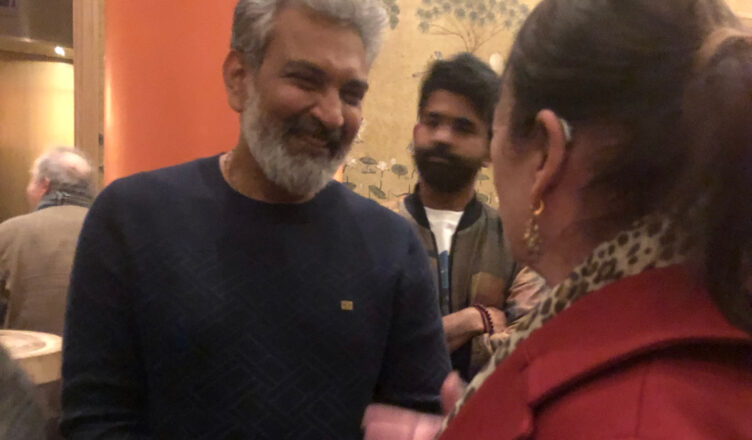If you haven’t had a chance to catch up with the action spectacular “RRR” (Rise, Roar, Revolt”) from Indian director S.S. Rajamouli yet, you are late to the party my friend. Even busy actor Jessica Chastain carved out three hours plus from her schedule to experience what all the fuss is about and then tweeted: “Watching this film was such a party.”
“RRR” features superstars Ram Charan and N.T. Rama Rao Jr. as friends and rivals in 1920’s India who clash but reunite in a struggle against the British colonialists. It’s a sort of bromance with lots of spectacular battle scenes and close calls with leopards, tigers, and wolves. There’s a fabulous dance sequence to the “Naatu Naatu” song, where our heroes wipe the floor with racist English toffs who challenge them and win over the adoration of the ladies who join them in their exuberant moves. “RRR” is over the top for sure and best to just surrender to the energy of the film.
Last week at a screening for Guild members, the crowd laughed, cheered, and stomped. The movie inspires that reaction, especially during the “Naatu Naatu” dance sequence. (On Twitter you can see audience members turn screenings into dance parties.)
Now the Tollywood film is a serious contender in the awards race. The New York Film critics gave Rajamouli the best director prize last week and composer M.M. Keeravani just received a Golden Globe for the infectious “Naatu Naatu” song, which is also Oscar shortlisted.
The film is a fantasy but loosely inspired by real-life revolutionaries, Alluri Sitarama Raju and Komaram Bheem, who battled the British colonialists but never met.
Here are some takeaways from the post-screening Q&A I attended:
Where Rajamouli got the idea for the story, which is co-written by his father, veteran writer, V Vijayendra Prasad:
“ I always like the idea of bringing two heroes together. Even when I was a kid, when I read two completely different stories, I would like to bring characters from the stories in my head and create my own scenes between them. Sometimes I’m a part of those scenes too. That’s how I thought as a kid.
And when I was reading the history of Komaram Bheem and Alluri Sitarama Raju, the revolutionaries from my part of the country, there were very interesting coincidences. They were on around the same time, at the turn of the 20th century. And when they were in their early twenties, they left their respective homes. And we don’t know what happened to them. No one knows what happened to them. And they came back after three, or four years and once they came back, they started fighting against the oppressors in the same way as in the film. I imagined… If I can take that period of time, those two, three years, and I can be a completely fictional story. So except for the fact that I named them Komaram Bheem and Alluri Sitarama Raju, everything else is fictional.”
On the visual effects:
“I have to see visual effects as a tool. Nothing more than that… Don’t treat visual effects like the star or something special.”
About working with these particular stars:
“They are good friends and they are friends outside their personal rivalry… Actually, the rivalry (is) between the fans of those two (actors)… when I started writing the characters with these guys in mind, they fit in so perfectly…For Charan, the way I look at him, when I look at him, his eyes seem to be as if they’re holding something very painful. And when I look at Tarak (N.T. Rama Rao Jr.) his eyes seem so innocent. There’s a lot of strength in the eyes… That’s the kind of feeling that I get when I look at those actors.”
On the shooting schedule:
“We shot it for 320 days. I mean, I’m not proud that I shot it for (so long)… I think my producers definitely are not proud that… I would like to do it much faster, but we don’t have second unit directors and third unit directors in India. So pretty much every sequence, every scene, almost every shot, I had to direct.
So because that’s such a big film with such big episodes, I had to shoot one episode, take a break, prepare for the next episode, and shoot it so it is more linear.”
Shooting the Naatu Naatu dance sequence:
“Both of them are exceptionally good dancers and we had a great song to showcase their dancing skills. And we had … a beautiful scene that leads up to the dance… Everything is properly put in. But still, I would give most of the credit of the success of that song for the dance choreographer, Prem Rakshith. He’s my choreographer. He spent almost two months composing for that number. And just for the two, three signature steps or the hook line steps, he composed more than 100 variations.
And you wouldn’t believe me. He had four sets of assistants, two assistants each and he was composing the steps for 15, 20 steps, 15, 20 variations. And the assistants were having cramps in their legs and pain in the knees. He would take out one couple and bring in another couple and start composing… The third couple or fourth couple had to go to the hospital because (of injuries).
So he was relentless in getting what he wanted and once the steps were composed, Tarak and Charan, like I said, they’re great dancers. They didn’t need too much time to practice the steps. They got it quite fast, but they also had to practice a lot because I wanted them to do the steps in exact sync.”
On the musical number at the end of the movie, which is a sort of roll call of politicians and freedom fighters:
“There are two, three reasons for that. One is, India had a long freedom struggle against the British (colonialist) for 90 years and almost 100 years before that…so many leaders laid down their lives fighting for the freedom of our country. As a kid, I read many of the stories, heard many of the stories, and some of the stories are so heart touching and I developed the kind of hero worship towards them.
Even though my film is not about freedom struggle, (primarily) … it’s about friendship, I thought at the end, it would be a nice way of paying tribute to freedom fighters. But I didn’t want to do that in a very sad way or something. I wanted it to be a celebratory kind of number… So all those things put together, I thought by going out of the theater, people should go out to the exuberant feeling, a high feeling.”
After the Q&A I caught up with Rajamouli at the reception where he was surrounded by fans and well-wishers. He posed for endless selfies and spoke to anyone who approached.
I asked him if the international global success of “RRR” caught him by surprise.
“Yes,” Rajamouli told me. “But it’s a wonderful surprise.”






